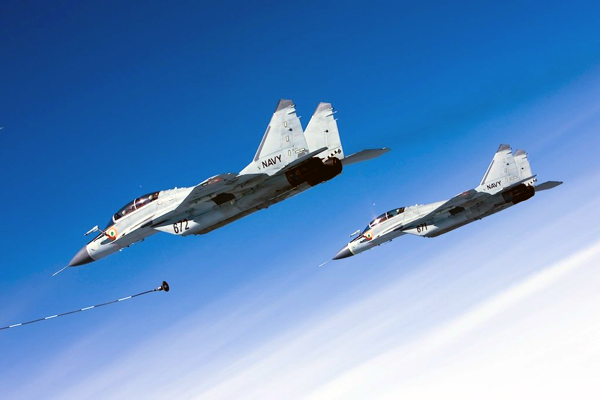|
This was disclosed by the newly-appointed Chief of Naval Staff, Admiral Robin Dhowan, on his first visit to
the Southern Naval Command here May 7. The aircraft carrier, earlier known as Admiral Gorshkov, had arrived
on its homeport of Karwar on India’s western seaboard a couple of months back and was immediately prepared
for deployment in the Arabian Sea.
"The Navy has inducted INS Vikramaditya. It is now operationally deployed with MiG- 29KUB aircraft embarked,
which are being flown by Indian naval pilots," Chief Dhowan told newsmen on the sidelines of naval functions.
A formal ceremony for its induction was to be held in March but as Naval Chief Admiral DK Joshi resigned
owning moral responsibility over a few accidents in the Western Naval Command area, the ceremony is now
likely to be held after the formation of a new Government post-elections.
The aircraft carrier meanwhile is busy as it should be with routine training as well as combat sorties. A
large number of the carrier’s crew, including pilots, aircraft controllers, engineers and technicians were
trained in Russia and more are being trained in India now. As for the aircraft, a Mig 29K simulator has
been installed at their naval airbase INS Hansa in Goa, where a 14-degree ski ramp like the one onboard
INS Vikramaditya has also been set up.
Pilots and crew are appropriately certified for deck landings and other operations.
It may be recalled
here that the initial batch of carrier pilots for the Russia-sourced vessel was trained at US naval facilities
using Goshawk aircraft. Deck landings are much more difficult than normal landings as an aircraft has to literally
hit the deck with full power on just in case it misses all the three arrester wires and has to take off again.
India has ordered a total of 45 Mig 29Ks from Russia. Compared to the 1980s-generation Mig 29s with Indian Air
Force (IAF), the naval Mig 29ks are a generation-plus aircraft, powered with newer engines, avionics and deadly missiles.

India now has two aircraft carriers, the other being INS Viraat, which however is kept afloat with periodic
refits till the Navy’s indigenous aircraft carrier, INS Vikrant, joins the naval flotilla in 2017. This carrier
is being built at Kochi, and considerable progress has already been made.
The steel for INS Vikrant, as well as India’s first indigenous nuclear sub, Arihant, has been developed and made in India.
The Navy is looking for at least one more – but preferably two – aircraft carriers, of 60,000 tonnes-plus. In a press
conference last year, Admiral Dhowan, then the Vice Chief, had said that all options were on the table including nuclear
power propulsion.
|